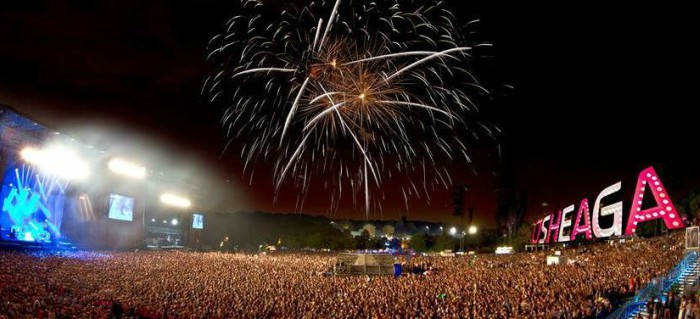Pulling big names like Arctic Monkeys, Florence + the Machine, ODESZA, Travis Scott and Tyler, the Creator for their 2018 edition, it’s cliché (but pretty much obligatory) to say that this is not the hippie-driven, muddy-camping festival envisioned by Woodstock’s creators.
Since transferring ownership to Evenko for its fifth edition in 2010, Osheaga has attracted big name sponsors, added gold and platinum ticket options, and pulled top 40 giants like Lana del Rey, The Weeknd, and Kendrick Lamar to headline. In 2016, the festival introduced Osheaga Play–a mixture of interactive activities and fairground rides that connect to RFID wristbands that allow festival goers to win prizes. The wristbands even allow photographers to snap pictures of attendees and upload them directly to their social media. It’s all very… Coachella.
Festival behemoth Coachella is notorious for its commercialization of the festival experience–with its celebrity guest list and reputation for trend-setting, fans show up to be seen having a good time with L.A.’s glitterati. Tickets range from USD $429 for general admission (GA) to $8,500 for a safari tent, which gets you entry to VIP areas, on-site concierge, and chauffeured golf course access among other.
Smaller festivals have watched Coachella target the one per cent and adjusted their prices accordingly. Some festivals realize that most people can’t afford their exorbitant prices—Bonnaroo now offers a payment plan for its most basic ticket, which comes to $337.50 plus fees.
Higher ticket prices mean festivals can afford bigger acts. This results in bigger sponsors and more revenue, which means next year’s festival can be even bigger. As festivals struggle to compete with this expansion, lineups become homogenised and lose their individuality. Everyone sets out with the goal of “bigger is better” and ends up with the same dozen headliners. Can’t make Osheaga? Tyler, the Creator, Post Malone, ODESZA, Portugal. the Man, St. Vincent, Chromeo, BØRNS, and BROCKHAMPTON, are all playing Coachella this year too.
It’s a self-perpetuating cycle—if festivals can promise big names, fans will pay more for tickets. This encourages festivals to seek out popular bands, which means looking at other festivals and seeing what’s making them money. Even Osheaga’s co-founder Nick Farkas admits to following trends, stating in 2015 in an interview with Billboard: “I’d imagine that pretty much every idea we’ve ever had we stole from someone else.”
With all the extras available, festivals have become social events as well as musical ones. Yet as festivals try to satisfy a smaller and smaller elite that can afford their three-figure day passes and caste-system perks, they lose out on the larger audience that can no longer afford—and is no longer interested in attending—today’s oversized festivals.
It’s not just the fans who are affected. Smaller bands can no longer compete for a spot at Osheaga if they’re already reserved for the same 50 acts currently on the festival circuit. Without large festival payouts, bands end up needing to tour more to make money. But touring also costs money; bands need a strong local base to start from before they can commit to playing shows outside of their city. This support comes from city and provincial arts funds, local talent promotion, and venues. Artists benefit most from community-oriented, not-for-profit organizations, such as POP Montreal.
Unlike Osheaga, POP Montreal has been committed to promoting local and international talent for the past 17 years. In addition to their annual five-day festival, POP promotes concerts year-round, holds stages at several festivals and organises gallery spaces and craft markets around Montreal. POP is not-for-profit, meaning the company’s focus is always on lineup quality and new talent promotion.
POP Montreal’s founder Dan Seligman believes that a city’s music scene is a delicate ecosystem. He breaks down some of the key issues of Montreal’s scene, starting with smaller venues’ licensing structures.
“When you’re a small performance space, you function differently than a bar that just sells alcohol, and that’s something that needs to be addressed,” Seligman said. “Smaller venues are set up as for-profit private companies but they function more in the realm of cultural, sometimes non-profit entities. Often smaller venues aren’t able to receive funding because they’re largely under the same jurisdiction as a bar.”
Seligman cites London as an example for Montreal to follow, where Mayor Sadiq Khan implemented a program to support small, grassroots venues that promote emerging talent. Khan believes in the transformative power of art and has invested more in London’s culture and creative industries than any of London’s previous mayors. Seligman believes that Montreal should adopt a similar program in order to preserve opportunities for bands that are starting out.
“There should be more of a long-term plan for the city, province, and potentially the federal government to support smaller venues,” Seligman said. “It would be beneficial for Montreal to look at how the various levels of government can support smaller venues that are important to small bands and emerging talent, because if there aren’t spaces to support these bands then the whole ecosystem is hurt. Smaller bands won’t become more popular and go on to play bigger venues like Club Soda or Metropolis.”
In light of recent closures, the need for governmental investment in Montreal’s arts and culture scene is more glaring than ever. Since streaming services and piracy have replaced CDs and actually paying for downloads, it’s more important than ever that emerging acts have access to performance spaces.
“Things have changed in terms of the ability to sell music,” Seligman said. “A lot of artists have to tour more, and the bigger corporate festivals end up being able to pay artists a lot more than they would normally be paid. It’s hard to not play a big festival when it [could be] such a big part of their income.”
The trick is getting big enough to be on the festival radar. Play Divan Orange enough times, and you get big enough to play Sala Rossa or Le Ritz, and then you can move on to Club Soda, and then Metropolis. By this point, ideally a band is big enough that Osheaga spots them and says, “Hey, come play our festival.” For bands that are already playing to crowds of 1000 people, this is easy enough—but for bands just starting out, venues like Divan Orange—set to close this spring—are necessary to get the word out and start building a fan base.
“It’s important to realize that there’s a greater ecosystem that supports music culture in a city,” Seligman said. “The city administration needs to figure out a way to support different levels of cultural participation. The bands that are headlining the big festivals start somewhere, so in order for them to get started, we need to be supportive.”










why write this article in the first place… there is no substance
Osheaga was founded by a promoter for Gillett entertainment with the express goal of becoming large enough to pull in bigger acts and bigger sponsors with Montreal’s “cool” factor as a marketing hook: there was never any Woodstock ideal behind it. It was “gentrified” in the same way a new McMansion “gentrifies” a suburb of slightly older McMansions. And Woodstock featured Hendrix and Crosby Still and Nash, so it’s not like it was ever intended to be a small indie showcase either. Don’t fall for Baby Boomer nostalgia: hippies liked to get paid too.